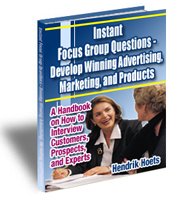How to Use Laddering
in Qualitative Marketing Research
Laddering is a qualitative marketing research technique, which seeks to understand why people buy and use products and services.
You find out which product features are important to product users and end with users’ emotional benefits.
You use the technique to create ads, positioning messages, and develop new products.
Thomas J. Reynolds and Jonathan Gutman developed and introduced laddering in 1988, based on Gutman’s Means-End Theory of 1982. They describe product attributes, consequences, and values. Product attributes produce consequences that produce personal meaning (values) for product users.
In other words, product features produce functional and emotional benefits, which are personal to the product user.
People buy features and benefits that satisfy emotions and beliefs. And they rationalize buying with features and functional benefits.
There are four levels to the features-benefits-emotions chain. They are,
- Features
- Functional benefits
- Higher Order benefits
- Emotional Benefits
Each level links to the next level. Each level influences buying behavior.
All four levels are important in understanding why people buy a product or service.
The feature is specific. It performs a specific job.
The functional benefit is the outcome of the feature. It is tangible.
The higher benefit is what the functional benefit delivers. It is a general benefit.
The emotional benefit satisfies feelings and beliefs. Features and functional benefits deliver emotional benefits.
Emotions are powerful motivators that drive wants or needs.
Emotions are general but real. They are personal. They are conscious and subconscious.
Features and functional benefits are specific. Features are important. They rationalize and justify buying. Features and benefits are easy to talk about. It is what business buyers use to rationalize buying, even though emotional benefits influence them too.
You can create powerful ads and positioning with the results from laddering.
How to Conduct It
A laddering question sequence usually consists of four questions related to a feature.
Sometimes, there may be more than four questions.
First, you ask about a feature.
“Which feature do you like best?”
Second, you listen to the answer, and then you ask about the feature’s functional benefit.
“What does the feature do?”
Third, you listen to the answer, and ask about the higher benefit of the functional benefit.
“What does the functional benefit do for you?”
Fourth, you listen to the answer again, and ask about the emotional benefit of the higher benefit.
“What does the benefit do for you?”
Once you’ve exhausted a feature, ask about other features and their functional, higher, and emotional benefits.
The technique asks about a specific product feature and poses a series of why questions that builds on previous answers.
Note…don’t use the word why. It puts people on the defensive. Ask why in different ways.
Using why is a mistake often seen in laddering.
Laddering works well with depth interviews.
Interviewing one person provides focus, depth, and privacy. You want to interview people who use the product or service category.
You can develop laddering chains at the category, brand, or product level.
An Example
Here is an example about sports scores on cell phones.
Moderator, “What do you like best about your phone?”Respondent, “Getting real-time sports scores” [feature]
Moderator, “What is important about that?”
Respondent, “I know what’s happening right away.” [functional benefit]
Moderator, “What does that do for you?”
Respondent, “I can tell my friends, as soon as I know.” [higher benefit]
Moderator, “What does telling your friends right away do for you?”
Respondent, “I am the go-to guy for sports. My friends expect me to know. It is what we talk about.” [emotional benefit]
In this example, sports scores on a cell phone lead to emotional benefits of social acceptance and friendship.
The same feature may lead to a different emotional benefit for a different person. It depends on the person. Emotional benefits are personal.
Features-Benefits-Emotions Maps
For each important feature, you identify and link functional benefits, higher order benefits, and emotional benefits. You link features to emotions. Map them out.
From left to right, the map moves from the tangible to the abstract; it moves from the rational to the emotional.
People buy features and benefits that satisfy personal emotions. And they rationalize buying with features and functional benefits.
You can consolidate respondent maps into one grand map of features, benefits, and emotions.
The grand map consolidates the collective chain of people you interview.
Applications
Use laddering results for advertising and positioning. You can also use it for product development and preliminary segmentation. It is a powerful technique, especially for advertising and positioning. Copywriters take note.
You write ads with features, benefits, and emotions. You use laddering to develop unique selling propositions in your ads.
Here is an imaginary example of advertising copy for the “in-the-know” sports phone.
“Be the leader of the pack [emotional benefit]. Tell your friends about baseball scores before they know [higher benefit]. Be in-the-know instantly [functional benefit] while on the go. Get the X sports phone. It’s the only one with real-time XYZ scores [feature].”
Emotional benefits can characterize segments of people. In the example of cell phones, here are two segments:
1. sports authorities (in-the-know)2. fantasy sports players
You can develop new products and services with laddering. You’ll know what features are important and how they relate to customers’ emotions.
People buy features and benefits that satisfy personal emotions. And they rationalize buying with features and functional benefits.
Use laddering to map out features, functional benefits, higher order benefits, and emotional benefits. Use it in depth interviews.
Check out the related article about buying theory.

Instant Focus Group Questions e-book is packed with over a hundred focus group questions. Learn more and download it today.
Return to Develop Questions from laddering
Return to Home Page


